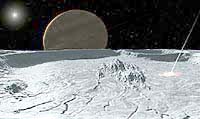Studies:
Global Warming Has Wide Impact (AP)
(Jan. 1) - Rising global temperatures that have lured plants into early bloom and birds to nest earlier in the spring are altering the ranges and behavior of hundreds of plant and animal species worldwide, two studies conclude.
From North America's marmots to Britain's birds, the findings could spell bad news for species already stressed by habitat loss if predictions of global warming over the next century pan out, the authors said in the studies, which appear in Thursday's issue of the journal Nature.
Other scientists said the studies, which are based largely on research done previously in Europe and North America, could foretell the extinction of many species in the coming decades as rising temperatures force them to retreat from their historic ranges or face new competitors.
Alastair H. Fitter, a professor of biology at the University of York who has documented the trend toward earlier-blooming flowers in Britain, said the studies' conclusions that the ranges of hundreds of species are shifting northward in response to warming temperatures are disconcerting.
He said the two papers show that plants and animals are already being affected by global warming, although Earth's average temperature climbed only about 1 degree Fahrenheit in the past century.
''These papers are the conclusive evidence that the natural world is already responding in a big way to climate change, even though that change has only just got going and there is a lot more to come,'' Fitter said.
A United Nations panel has predicted that average global temperatures could rise as much as 10.5 degrees Fahrenheit over the next century as heat-trapping gases from human industry accumulate in the atmosphere.
Fitter said if that occurs it may drive some plant and animals species to extinction as their ranges shrink or they are forced to compete with other species moving into their territory.
Working independently, two research teams reviewed hundreds of published papers that tracked changes in the range and behavior of plant and animal species believed caused by human-driven global warming.
Both teams concluded that they had found the ''fingerprint'' of global warming on hundreds of species, from insects to birds and mammals, even after taking into account other possible causes such as habitat loss.
Other scientists said the two studies, in pulling together hundreds of published scientific papers for two comprehensive analyses, add another piece of evidence - along with retreating glaciers, warming oceans and shrinking snow cover - that global warming is impacting the Earth.
Mike Novacek, provost of science of the American Museum of Natural History in New York, said much of the data in the two papers was based on studies of wildlife found in North America and the United Kingdom.
New research of plants and animals representing a wider range of Earth's life would conclusively pin down the evidence, said Novacek, who was not involved in the research.
Camille Parmesan, a biologist at the University of Texas at Austin, worked with a colleague to review studies that tracked about 1,700 species, often over several decades. While about half of the species showed no changes in behavior or range shifts, the changes seen in the other half clearly pointed to global warming as the culprit, she said.
''The climate scientists have really shown that global warming is happening. What we've found is that it's not only happening but it's having a big impact,'' she said.
In an analysis of 172 species of plants, birds, butterflies and amphibians, Parmesan found that spring events such as egg-laying or flower-blooming advanced 2.3 days on average each decade.
Her analysis of studies of 99 species of birds, butterflies and alpine herbs in North America and Europe found these species' ranges have shifted northward an average of about 3.8 miles per decade.
Most striking, she said, was the case of the sooty copper, a butterfly common near Barcelona until recent decades. These days, however, residents of the Spanish city must travel about 60 miles north to find this butterfly.
Meanwhile, the sooty copper's northern range, which once ended in Austria, has shifted into Estonia during the past five years, Parmesan said. The insect had previously never been seen in that Baltic nation.
A second study by Stanford University researchers reviewed scientific studies that involved more than 1,400 plant and animal species.
Terry L. Root, a senior fellow at Stanford's Institute for International Studies, and five colleagues determined that about 80 percent of those species have undergone range or behavioral changes likely caused by global warming.
They found, for example, that the earlier arrival of spring weather had shifted events such as egg-laying, the end of hibernation and flower blooming ahead about 5 days per decade for temperate-zone species.
---
On the Net:
Nature:
http://www.nature.comUniversity of Texas:
http://www.biosci.utexas.edu/IB/Stanford University:
http://iis.stanford.edu AP-NY-01-01-03 1429EST


















































